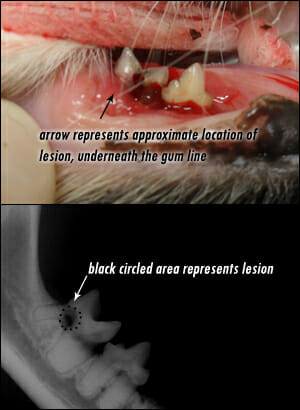Cats have an oral disease process that is very specific to their species, called feline odontoclastic resorptive lesions. That’s a mouthful! When visible to the naked eye, they appear as erosions on the surface of a tooth, often associated with gingivitis (red, inflamed gums) in the progressive stages. There are no specific causes that have been clearly identified, though recent research suggests that prolonged inflammation (from dental plaque and bacteria) and excessive amounts of vitamin D may play a part.
They are extremely painful and unfortunately extremely common, with over 30% of cats developing them in their lifetime. The premolars and molars are the most likely teeth to be affected, but they can also be found on the canines (‘fangs’) and incisors (the tiny teeth at the front of a cat’s mouth). These defects are often covered with calculus (tartar) and may not be noticed until the calculus is removed. The lesions may also be covered by hyperplastic gingiva (excessive gum growth due to inflammation) and filled with granulation tissue. Cats with these lesions are often, but not always, reluctant to eat hard food due to the pain involved. Others will swallow kibble whole without chewing or direct kibble to non-painful parts of the mouth. These lesions can so painful that even when the cat is under anesthesia, the cat’s jaw will twitch when the lesions are touched! Affected cats are typically middle-aged, but they have been seen in cats as young as 2 years of age. Purebred cats are the most susceptible, with the Persian and Siamese having the highest incidence.
The only treatment is complete extraction of the tooth and associated tissues, and often they are only identified by dental x-rays, as their development and origin begins underneath the gum-line.
